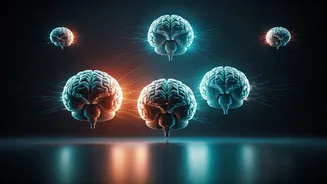The Ripple Effect
The concept of emotional contagion proposes that emotions can spread from one person to another, acting like a social infection. This happens through both
conscious and unconscious processes. When exposed to someone else's fear, our brains may start to mirror their emotional state, triggering similar responses in us. This mirroring occurs on a neurological level through mirror neurons, which fire both when we perform an action and when we see someone else perform it. Additionally, our emotional state is affected by social cues such as body language, facial expressions, and vocal tones. If we witness someone exhibiting signs of fear, our brain processes these cues, and we may start feeling afraid as well. This process can be particularly strong in groups, amplifying emotional responses and creating a collective experience of fear, which can lead to heightened anxiety and potentially irrational behaviors.
Neurological Pathways Unveiled
Understanding the brain's role is critical to comprehending how fear propagates. The amygdala, a key structure in the brain, plays a critical part in processing emotions, particularly fear. When we see or sense fear in others, the amygdala activates. This activation then sets off a chain reaction within the nervous system. The activation of the amygdala can trigger the release of stress hormones, which cause a cascade of physical reactions such as rapid heart rate, muscle tension, and heightened awareness. These physical symptoms, coupled with the emotional experience of the person experiencing fear, help to amplify the feeling and make it more contagious. Furthermore, the prefrontal cortex, which is responsible for cognitive control, also comes into play. It assesses the threat level of a situation. However, in stressful situations, the prefrontal cortex can become less efficient, meaning our rational thinking may be overridden by the raw emotional input from others. This combination means that we can quickly find ourselves experiencing fear that's not necessarily our own.
Social Dynamics Impact
Social context has a major effect on how fear spreads. In groups, the effects of fear are amplified. This is partly due to a phenomenon called social referencing, where we look to others for clues on how to interpret ambiguous situations. If we see that others around us are fearful, we may assume the situation is dangerous, even if there's no objective evidence of danger. This can create a feedback loop where fear spreads from one person to another. Furthermore, social media can act as a powerful catalyst for emotional contagion. News or posts about fearful events spread quickly across various platforms, often without appropriate context or balance. This can lead to increased anxiety, especially when individuals are already predisposed to be sensitive or have high anxiety levels. The speed and reach of these platforms make it harder to filter out misinformation, so fears can go viral very rapidly. It's important to be aware of the influence of social dynamics on how fear spreads and consider the source of information.
Everyday Manifestations
Fear contagion is something we can experience in everyday scenarios. Consider a workplace where there are layoffs. If some employees are anxious, others might pick up on it, even if they aren't directly at risk. Similarly, in a crowded public space, a sudden moment of panic, such as a fire alarm, could quickly spread, even if the actual danger is minimal. Healthcare settings are also highly susceptible to this type of contagion. Patients in the waiting area, observing a nervous reaction from others, are likely to exhibit the same anxiety. Watching a horror movie with friends is another example, where the collective experience of fear is intensified. In situations such as these, heightened awareness is essential, as is a rational approach to evaluating the cause of the fear. Recognizing these instances can assist in managing the effects of emotional contagion and promoting emotional well-being.
Managing Contagion
Various tactics can help to manage the effects of fear contagion. Self-awareness is key. Recognize when you're experiencing heightened anxiety in social settings, then examine whether your feelings match the actual threat. Limit your exposure to potentially anxiety-provoking information. In the age of constant news cycles and social media, be cautious about the media that you consume. Seek balanced sources and try to avoid sensationalized content that could trigger fear. Practicing mindfulness and relaxation techniques can also help to regulate your emotional responses. Deep breathing, meditation, and other techniques help calm your nervous system, allowing you to deal with stress in a more composed way. Social support is another important factor. Connect with others who provide emotional support. Talking about your fears can also help you process them, lessening the potential for emotional contagion to take hold.











